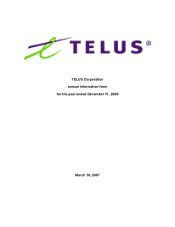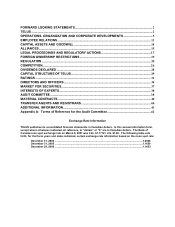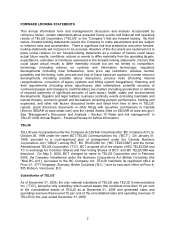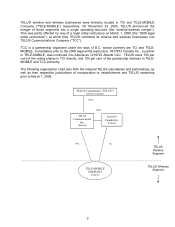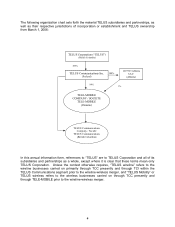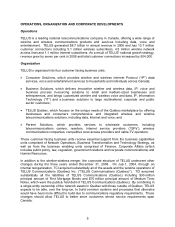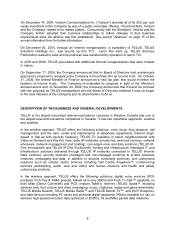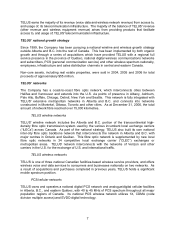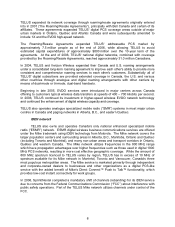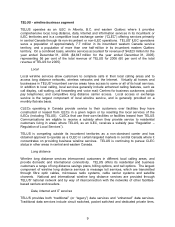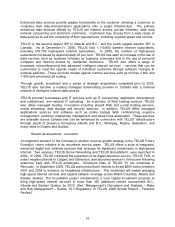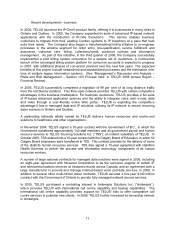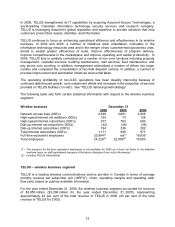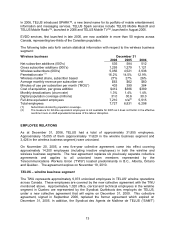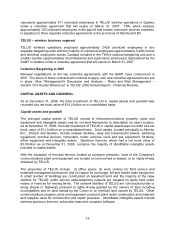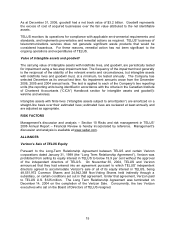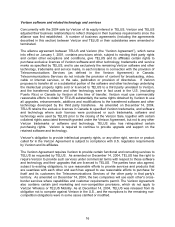Telus 2006 Annual Report Download - page 8
Download and view the complete annual report
Please find page 8 of the 2006 Telus annual report below. You can navigate through the pages in the report by either clicking on the pages listed below, or by using the keyword search tool below to find specific information within the annual report.TELUS earns the majority of its revenue (voice data and wireless network revenue) from access to,
and usage of, its telecommunication infrastructure. The majority of the balance of TELUS’ revenue
(other revenue and wireless equipment revenue) arises from providing products that facilitate
access to, and usage of, TELUS’ telecommunication infrastructure.
TELUS’ national growth strategy
Since 1999, the Company has been pursuing a national wireline and wireless growth strategy
outside Alberta and B.C. into the rest of Canada. This has been implemented by both organic
growth and through a series of acquisitions which have provided TELUS with a regional full
service presence in the province of Québec, national digital wireless communications networks
and subscribers, PCS (personal communication service) and other wireless spectrum nationally,
employees, infrastructure and sales distribution channels in central and eastern Canada.
Non-core assets, including real estate properties, were sold in 2004, 2005 and 2006 for total
proceeds of approximately $55 million.
TELUS’ networks
The Company has a coast-to-coast fibre optic network, which interconnects cities between
Halifax and Vancouver and extends into the U.S. via points of presence in Albany, Ashburn,
Palo Alto, Buffalo, Chicago, Detroit, New York and Seattle. This network is fully integrated with
TELUS’ extensive metropolitan networks in Alberta and B.C. and connects into networks
constructed in Montréal, Ottawa, Toronto and other cities. As at December 31, 2006, the total
amount of network fibre reached over 15,000 kilometres.
TELUS wireline networks
TELUS’ wireline network includes the Alberta and B.C. portion of the transcontinental high-
density fibre optic transmission system used by the various incumbent local exchange carriers
(“ILECs”) across Canada. As part of the national strategy, TELUS also built its own national
inter-city fibre optic backbone network that interconnects the network in Alberta and B.C. with
major centres in Ontario and Québec. This fibre optic network is supplemented by new local
fibre optic networks in 34 competitive local exchange carrier (“CLEC”) exchanges or
metropolitan areas. TELUS’ network interconnects with the networks of Verizon and other
carriers in the U.S. for the exchange of U.S. and international traffic.
TELUS wireless networks
TELUS is one of three national Canadian facilities-based wireless service providers, and offers
wireless voice and data services to consumers and businesses nationally on two networks. As
a result of acquisitions and purchases completed in previous years, TELUS holds a significant
mobile spectrum position.
PCS/cellular networks
TELUS owns and operates a national digital PCS network and analogue/digital cellular facilities
in Alberta, B.C., and eastern Québec, with 40 to 45 MHz of PCS spectrum throughout all major
population regions of Canada. Its national PCS wireless network utilizes 1X, CDMA (code
division multiple access) and EVDO digital technology.
7

